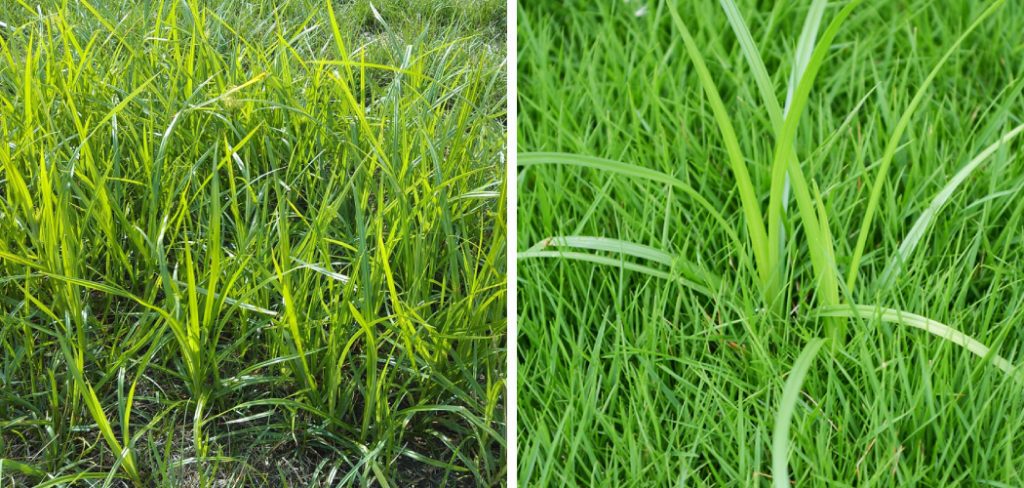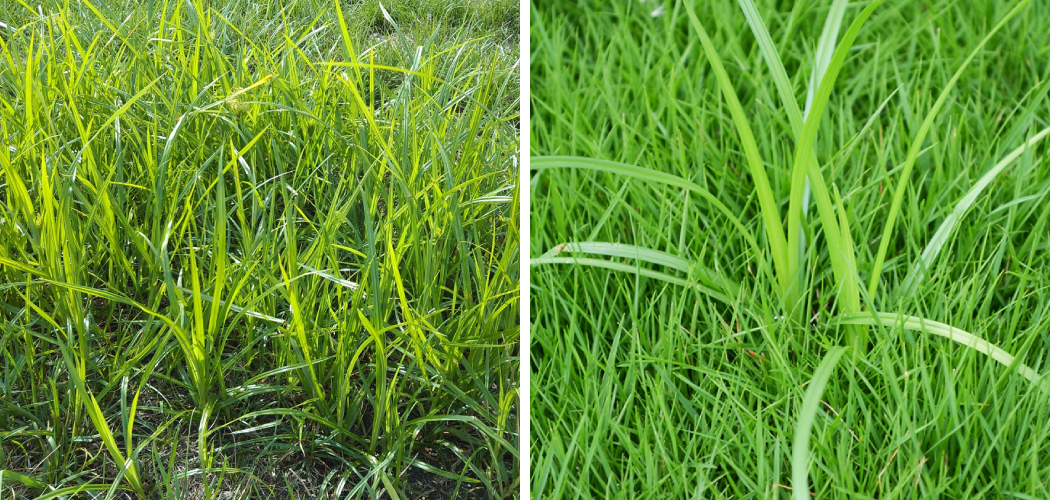To remove nutsedge from your yard, use a combination of manual and herbicidal methods. Manual methods involve pulling out the nutsedge plants by hand, including the roots, while herbicidal methods include applying a selective herbicide specifically designed to target nutsedge.
This combination approach is effective in eradicating nutsedge and preventing its regrowth. Nutsedge, also known as nutgrass, can be a persistent and invasive weed that can quickly take over your lawn or garden. Its fast growth and ability to produce underground tubers make it difficult to eliminate.
However, by following the appropriate steps and using the proper techniques, you can successfully remove nutsedge and restore the beauty of your outdoor space. We will discuss the different methods and strategies you can use to eliminate nutsedge and prevent it from coming back.

Understanding Nutsedge: A Common Lawn Weed
Nutsedge, also known as nutgrass, is a common lawn weed that can be a real nuisance. Its distinct triangular stem and yellowish-green leaves make it easily identifiable. This troublesome weed thrives in moist soil and can quickly take over a lawn if left unattended.
Nutsedge can be challenging to remove as its roots are deep and extensive, making it resistant to traditional methods of weed control. However, there are effective ways to combat nutsedge. Using herbicides specifically designed to target this weed can help eradicate it from your lawn.
Additionally, regular mowing and proper lawn maintenance practices can discourage the growth of nutsedge. Understanding the characteristics and behavior of nutsedge is crucial in successfully removing it from your lawn and ensuring a healthy, weed-free environment.
How to Remove Nutsedge: Step by Step Guide
Identifying Nutsedge In Your Lawn
Nutsedge can be a pesky weed in your lawn, but identifying it is the first step to removing it. With its distinct physical appearance and distinguishing features, nutsedge stands out among other similar weeds. Its triangular stems and glossy leaves make it easily recognizable.
Unlike grass, nutsedge has a different growth pattern, shooting up taller and faster. It reproduces through underground tubers, multiplying rapidly if left untreated. Pulling nutsedge manually can be challenging because the tubers are left behind, allowing it to regrow. To effectively remove nutsedge, herbicides specifically designed for this weed can be used, targeting its deep roots.
Regular maintenance, including proper lawn care practices, like mowing at the correct height, can help prevent nutsedge from taking over your yard. By staying vigilant and taking proactive measures, you can successfully eradicate nutsedge and maintain a healthy, weed-free lawn.
The Impact Of Nutsedge On Your Lawn
Nutsedge can quickly invade and weaken your lawn, leading to significant negative effects on its appearance. This invasive weed has the ability to overtake your grass, spreading rapidly and forming unsightly patches. Its distinctive triangular stem and yellowish-green leaves make it easily distinguishable from desirable grass species, causing a visual eyesore.
Nutsedge grows at a faster rate than most lawn grasses, competing for essential nutrients, water, and sunlight. Additionally, it can withstand drought conditions better than other plants, further exacerbating its ability to dominate your lawn. Its deep and resilient root system makes it difficult to eradicate, requiring specialized techniques for effective removal.
By understanding the impact of nutsedge on your lawn’s aesthetics, you can take proactive measures to prevent and remove this stubborn weed, ensuring a healthy and visually appealing lawn.
Prevention And Cultural Control Methods
Proper watering and mowing practices play a vital role in preventing and controlling nutsedge growth. By watering deeply and infrequently, you can encourage deep root growth in your desired plants while depriving nutsedge of the moisture it needs to thrive.
Similarly, maintaining the recommended mowing height for your lawn can help shade the soil, reducing the likelihood of nutsedge invasion. Additionally, implementing aeration and soil improvement strategies can discourage nutsedge from taking hold. Regularly aerating your lawn can improve drainage and break up compacted soil, making it less favorable for nutsedge to establish itself.
Furthermore, amending the soil with organic matter can create an environment where desirable plants thrive, leaving little room for nutsedge to grow. By following these prevention and cultural control methods, you can effectively remove nutsedge and maintain a healthy and beautiful landscape.
Organic Nutsedge Removal Methods
Nutsedge can be a pesky weed in your garden, but there are effective organic methods for removing it. One option is using natural herbicides that specifically target nutsedge. These herbicides are made from organic ingredients and are safe for the environment.
Their effectiveness against nutsedge is well-documented, and they can significantly reduce the presence of this weed in your garden. Another method is manual removal, which works best for small infestations. By carefully digging up the nutsedge plants, including their bulbs and roots, you can eliminate them from your garden.
This manual removal technique requires some time and effort, but it can be successful in controlling nutsedge. Overall, these organic methods provide a safe and effective way to remove nutsedge from your garden without resorting to harmful chemicals.
Chemical Nutsedge Removal Methods
Chemical nutsedge removal methods can be an effective way to eradicate this pesky weed from your lawn or garden. Selective herbicides are the recommended solution for targeting nutsedge specifically, without harming desirable plants. These herbicides work by selectively attacking the nutsedge while leaving other plants unharmed.
When using chemical treatments, it is important to follow proper application guidelines and safety measures to ensure a successful and safe outcome. Be sure to read and follow the instructions on the herbicide label carefully, wearing protective clothing and avoiding contact with the skin and eyes.
Additionally, apply the herbicide when the nutsedge is actively growing for the best results. By using selective herbicides with caution and following proper application methods, you can effectively remove nutsedge and restore the health and beauty of your lawn or garden.
Long-Term Nutsedge Management
Healthy lawns are crucial for long-term nutsedge management. Regular monitoring and early intervention are of utmost importance. One must ensure the lawn is well-maintained to prevent the regrowth of nutsedge. Implementing effective strategies like proper watering, mowing, and fertilization can help maintain a healthy lawn.
Adequate watering should be done deeply and infrequently to encourage deep root growth and discourage nutsedge growth. Mowing at the correct height and frequency will prevent the weed from spreading. Fertilizing the lawn with the right nutrients will enhance its overall health and make it less susceptible to nutsedge invasion.
Maintaining good soil health by aerating and overseeding will also contribute to a robust lawn. By following these practices, one can effectively manage nutsedge and enjoy a lush, weed-free lawn.
Integrating Nutsedge Control Into Your Lawn Care Routine
Nutsedge can be a pesky problem in your lawn care routine. To effectively remove it, incorporate these tips into your regular maintenance. Firstly, stay vigilant and address nutsedge growth promptly. Secondly, utilize proper lawn mowing techniques, keeping the grass at the recommended height.
Thirdly, implement regular watering schedule to maintain a healthy lawn, as nutsedge thrives in moist conditions. Additionally, consider using organic herbicides specifically designed for nutsedge removal. Moreover, practicing good lawn fertilization practices can help promote a dense turf that can withstand nutsedge intrusion.
Lastly, make sure to remove any nutsedge root bulbs, as they can lead to reinfestation. By following these best practices, you can keep your lawn healthy and free from nutsedge for good.
Seeking Professional Help For Nutsedge Removal
Seeking professional help for nutsedge removal is crucial for the health and appearance of your lawn. Lawn care experts have the experience and knowledge to determine the right time for removal and understand the reasons behind its growth. They provide a range of services and treatments tailored to effectively eliminate nutsedge and prevent its future recurrence.
These professionals use specialized equipment, such as herbicides and weed control techniques, to ensure maximum effectiveness. They can also offer advice on lawn maintenance practices and recommend strategies to keep nutsedge at bay. By consulting a professional, you can save time and effort while achieving long-lasting results for your lawn.
Don’t hesitate to reach out to a lawn care expert for help with nutsedge removal.
Frequently Asked Questions Of How To Remove Nutsedge
How Do I Permanently Remove Nutsedge?
To permanently remove nutsedge, follow these steps: 1. Identify the nutsedge: nutsedge has triangular stems, glossy leaves, and distinct seed heads. 2. Remove the plants: use a hand tool or garden fork to dig out the entire plant, including the underground tubers.
3. Prevent regrowth: ensure all tubers and roots are removed to prevent nutsedge from growing back. 4. Apply herbicides: use selective herbicides specifically designed to target nutsedge. Follow the instructions carefully for effective results. 5. Improve lawn health: maintain proper lawn care practices, such as regular mowing and adequate watering, to discourage nutsedge growth.
6. Mulch garden beds: apply a thick layer of organic mulch in garden beds to inhibit nutsedge growth. 7. Monitor for re-emergence: keep an eye out for any new nutsedge growth and repeat the removal process if necessary. By following these steps consistently, you can permanently eliminate nutsedge from your lawn or garden.
What Will Kill Nutsedge But Not Grass?
Apply selective herbicides like sulfentrazone or halosulfuron to kill nutsedge while sparing grass. These herbicides target the nutgrass weed, without harming the surrounding grass. Applying the herbicide at the correct timing and following proper instructions is crucial for effectiveness. Additionally, maintaining a healthy lawn by proper watering, mowing, and fertilizing can help prevent the growth of nutsedge.
Regularly removing the weed by hand, ensuring the root is completely extracted, can also be effective. Implementing these strategies consistently will help control nutsedge and maintain a lush, weed-free lawn.
Should You Pull Out Nutsedge?
Pulling out nutsedge can be effective in controlling its growth in your garden or lawn. By removing the plants, you can prevent them from spreading and competing with other desired plants for nutrients and water. However, it’s important to note that nutsedge has an extensive root system, so pulling out the plant alone might not entirely eradicate it.
Regular and persistent pulling is necessary to manage its growth. Additionally, it is advisable to use other control methods in conjunction with pulling, such as applying herbicides specifically designed for nutsedge. Overall, pulling out nutsedge can be a part of an effective control strategy, but it requires consistent effort and the use of other methods to achieve long-term results.
Does Mowing Nutsedge Spread It?
Mowing nutsedge doesn’t spread it.
Conclusion
Overall, removing nutsedge from your lawn can be a challenging task, but with the right approach and persistence, you can achieve a weed-free yard. Start by identifying the nutsedge plants and understanding their growth patterns. Then, choose the most suitable control method for your situation, such as hand-pulling, using herbicides, or applying organic remedies.
Remember to follow the instructions carefully and take necessary safety precautions. Additionally, maintaining a healthy and well-maintained lawn can help prevent the growth of nutsedge in the first place. Regular mowing, proper watering, and adequate fertilization will go a long way in keeping your lawn strong and dense, making it more resilient to weeds.
By implementing these strategies and staying vigilant, you can enjoy a beautiful and nutgrass-free lawn for years to come. So, invest some time and effort in removing nutsedge, and your lawn will thank you with its lush greenery.

